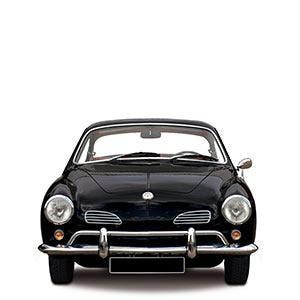Range Rover Buying Guide
The Range Rover is surely one of the most renowned names and highly significant vehicles in the history of motoring. Widely considered to be the world's first vehicle that was as good on-road, as it was off-road.
The idea to develop a larger more refined version of the Land Rover Series first originated in 1951. However, it took until 1966 before the idea became a working reality, when engineers produced prototypes between 1967-69, under the decoy name Velar. Taking inspiration from the Italian ‘velare’ meaning to veil or cover. Around 40 of these pre-production Range Rovers were built (and can still be accounted for today). The new model was launched in 1970 under the now revered name Range Rover when it was even displayed in the Louvre in Paris as an “exemplary work of industrial design”.
Iconic design
The shape of a Range Rover is instantly recognisable. Land Rover’s former design director noted that the Range Rover can be described with three or four lines on a piece of paper. Its basic shape is instantly recognisable in the same way as a Mini, or a Porsche 911, or a Volkswagen Beetle.
The Range Rover design consists of no more than five key elements: the simplicity of the side elevation, the relationship of the glass to the body, the floating roof and the castellated bonnet. This simplicity extended to the interior of the car too. Designed so that people sit as far out as possible and enjoy the best view, looking out down the bonnet and all corners of the vehicle.
Like many design greats, form followed function. The drive for outstanding functionality led to a simple but now legendary style and shape.


The Range Rover Classic
The first generation of Range Rover was so far ahead of its time that it lasted in production, with strong sales, for more than 25 years. From inception and throughout the 1970s, the vehicle changed very little. The UK motor industry was suffering in a poor economic climate and as such there was precious little development budget, but with the Range Rover selling well, owners British Leyland spent their restricted development money elsewhere.
By the 1980s, the Range Rover development gathered pace, largely focused on refinement and luxury. Cabin trim was regularly upgraded, with carpet, leather upholstery and wood trim elevated to raise the status of the Range Rover into a viable alternative to luxury saloon cars - the first 4x4 to do so.
The Classic was initially powered by Rover's staple 3.5-litre V8, followed by the 2.4-litre turbo diesel engine. At the end of 1989, the 3.5 gave way to a catalysed 3.9-litre V8 and the turbo diesel was uprated to 2.5-litres. A 4.2-litre long wheelbase model was added at the end of 1992 and the Discovery Tdi engine replaced the turbo diesel in 1993. The final models from 1994-96, shared the Discovery's redesigned 300 Tdi turbo diesel engine.
The petrol V8 is the most popular engine by far. Though a little thirsty, it’s a strong and generally reliable engine that will happily rack up the miles if properly maintained. The VM diesel engines are slow but relatively durable, though suffer from a common issue of blown head gaskets. Later TDi engines are the better option and have proven to be more reliable.
Official oil change recommendations say every 6000 miles, but most specialists will advise 3000 miles.
Regular changes prevent wear to the camshaft and helps to prevent the sludging of the engine’s top end. A tappety sounding engine is a sign that you’ll soon need to remedy worn components.
Today the Range Rover Classic is considered the golden era of the family lineage with desirability and values climbing steadily, assisted by a number of specialist and restomod companies producing models with blend of classic styling and modern-day comforts.




The P38a
The second generation, now commonly referred to as the 'P38a' (owing to it being developed in building 38A in the Solihull factory), was considered evolutionary in design, with burr walnut and leather upholstery used extensively throughout the interior to underscore the car's luxury credentials, and its desire to win over owners of conventional luxury cars.
The height adjustable suspension, which made its debut at the twilight of the Classic's life, was further developed for the P38a and was offered as standard, improving both ride comfort and off-road potential.
Three engines were offered for the P38a, including a BMW 2.5 six-cylinder turbo diesel (with output performance considerably better than the old Classic diesel) and a 3.9 and 4.6 version of the aluminium Rover V8. The 4.6 gave a top speed of 125mph and 0-60 acceleration in 9.3 seconds, the fastest production Range Rover at that time.
One of the common issues to be aware of on the P38a is engine trouble relating to either overheating (cracked block or cylinder head gaskets) or coolant getting into the combustion chamber leading to a very expensive fix – check levels frequently.
Under proper operation, the air suspension is a party piece of the Range Rover, but when the airbags perish, they cause the compressor to work overtime and burn out, so they need to be replaced promptly.
Pop the suspension up to its highest setting (if it's slow to rise, the compressor pump is on its way out) and check to see if the airbags are cracked around the base. If that’s the case, they won’t last long.
Electrics tend to be the P38a’s Achilles heel. Particularly the ECU. There are ECUs under the front seats, as well as under the bonnet, so if it’s been wading through streams there’s a strong possibility the ECUs have seen water ingress.
The P38a has a loyal but lesser following today, in comparison to all other eras of Range Rover. Generally considered as a bit of a miss in terms of time-tested desirability, however, well-maintained examples are one of the best value Range Rovers to own.


The L322
The third generation L322 now lies precisely in the middle of the Range Rover’s lineage and has become what some consider to be the peak Range Rover. The versatility of Land Rover’s halo model had leapt forward in terms of all three of its defining attributes: offroad capability, levels of luxury and everyday effortlessness. On the road, the plush ride and highly appointed cabin will have you feeling like royalty. Venturing offroad will see you deftly deal with loose muddy tracks or challenging undulating terrain alike. The real beauty of the L322 is that has aged like fine wine. Introduced in 2001, with two face-lifts in 2006 and 2010, the L322 always felt fresh and modern, with the model now being looked back upon as a design triumph and today represents real value for a high-end premium SUV. Values of the L322 Range Rover remain strong for well-maintained examples, with the rarer, high-specification models commanding higher values than fourth-generation Range Rovers.
Initially, there was a choice of BMW engines: the 3-litre diesel (lifted from the 330d E46, 530d E39 and 730d E38) and 4.4-litre V8 petrol (as per the 5-Series 540i E39 and 7-Series 740i/740iL E38 models), which sounds sublime and really packs a punch both in acceleration and speed, despite the Rangie’s 2.5 tonnes. The biggest change came in 2005 when Ford exited the BMW engine and technology supply agreement and saw fit to equip the L322 with the 4.2-litre Jaguar V8 engine, the first pairing of Jaguar and Land Rover technology, ahead of what we now know as the current partnership. 2007 saw the introduction of the new 3.6-litre TDV8 diesel. Towards the end of production, a 5-litre supercharged V8 saw out the flagship L322, before being succeeded by the fourth-generation model.
The L322 is not one to buy cheap and expect it to be trouble and maintenance-free. Strong service history is key, and you should look for examples that have proof of recall and technical service bulletin rectification, as well as drivetrain and suspension refurbishment.
With the engine running, listen out for whining turbos and injector misfires on the 3-litre diesel. Check the water pump was replaced at the cambelt change. On 4.2-litre models, listen for a rattle from the supercharger at idle. Inspect for exhaust wear and check the catalytic converter isn’t breaking up.
If the gearbox is troublesome in its changes and the dash warning light is on, be prepared for a big bill. While the sticker may say ‘sealed for life’, with the earlier cars being over 20 years old now, it’s advisable to do a fluid change.
That air suspension ride is utterly sublime. When it works. Roll through the three ride-height settings to ensure it travels up and down smoothly and quietly. Again, check the service history for air compressor checks or replacements. Listen for noisy wishbones and rear hub bushes.
Don’t let the fact it’s over two decades old make you think this is a classic. It has enough technology and electrical components to make life difficult if it’s not been looked after. Buy well, maintain well and the L322 will prove to be a rewarding and luxurious place to be.




The L405
Fourth-generation Range Rovers have only recently ceased production, and during their near-decade run (2012 – 2021) they successfully delivered yet another progressive generation of Range Rover, which offered more power, capability, and comfort. The drive is now an expected level of superior position when sat cosseted in the cabin and confident road holding which defies its size and weight. While the L405 Range Rover grew in size from its predecessor, the two-and-a-half tonne haven of peace and tranquillity moves effortlessly through cityscapes, open roads or arable land.
The L405’s biggest leap forward was the use of an all-aluminium monocoque body, resulting in a claimed 450kg reduction in weight.
The popular engine choices when new were one of the two 3.0-litre diesel V6s which provided strong performance and adequate economy, while the 4.4-litre V8 increased the speed at the expense of fuel economy. For the first time, the Range Rover had the option of a diesel-electric hybrid power unit and a 2.0-litre petrol hybrid, known as the P400e, both offered improved efficiency, albeit with very limited electric range. The range-topping 5.0-litre supercharged petrol V8 brings stunning acceleration but equally eye-watering fuel consumption.
Servicing can be expensive, especially for later-year models, where maintaining dealer or specialist history is still advisable to retain values.
The lineage of Range Rovers appears to have carried with it the same areas of issues, spanning a wide range of areas, primarily focussed on air suspension, engine leaks, engine electrics, air conditioning, electrics inside the car, gearbox and drivetrain. That said, these recurring problems on the L405 seem to be primary with earlier pre-2015 models. The SDV8 4.4 diesel has shown to be a more reliable choice in comparison to the TD V6 3.0-litre diesel. The V8 diesel doesn't appear to suffer from the V6 engine's crankshaft bearing issues, nor does it need an expensive timing belt.
With the ever-increasing complexity of the modern Range Rovers, pre-purchase inspections and a sound, well-documented service history are the best way to ensure your luxury daily driver is a low-stress affair that will keep you wafting effortlessly through many miles of roads or tracks alike.




The fifth generation
The fifth generation isn’t just the new model of Range Rover: it's the beginning of a new Land Rover era. The latest design lays down the marker for the brand's new fully electric range which moves to a full-battery version of each of its models set to be available before the end of the decade - beginning with a fully electric Range Rover from 2024.
In the meantime, the mild hybrid and PHEV plug-in engine options continue as part of the fifth generation, which's been completely redesigned, upgraded and updated.
It’s too soon to know how the new era of Range Rover will perform, but one thing is for sure, its capability, familiar design and well-appointed luxury will see strong demand the world over.




Where to buy a Range Rover?
Finding the right Range Rover for you is a case of first knowing what era you’re looking for and what condition suits your budget. This will dictate where to look, whether it’s a Land Rover specialist (of which there are plenty), private sales, auctions and online vehicle sales or from dealerships.
With the Range Rover enjoying such a loyal following, there is no shortage of buying options to suit all budgets and preferences. Maintenance support and parts are widely available, whether you’re in need of a standard service to maintain a well-documented service manual or a full nut and bolt restoration. There is no shortage of expert knowledge and a support network for each generation of Range Rover, which should give you buyer confidence, particularly if you’re less inclined to work on the car yourself.


How much is a Range Rover?
The very best of the first gen Classic have seen values in excess of £85,000, for the earliest and rarest ‘Velar’ models. Subsequent two door Range Rovers will vary from £14,000 for a project car up to £40,000. Four doors tend to be a little cheaper, with condition ranging from £11,000 to £30,000.
As previously mentioned, the second generation P38a offers the best value for get into Range Rover ownership, with project condition cars starting at around £2000, progressing up to the very best examples commanding a little over £12,000.
The L322 third gen Range Rover currently offers the best opportunity to experience relatively ‘modern’ luxury and technology, without the lofty price point of the later generations. Prices begin from as little as £3000 for the poorest examples, but quite honestly, just don’t. The best examples are around £20,000, but a well maintained and sensible mileage car can be had for between £10,000 to £15,000.
Fourth and fifth generation cars are currently being sold on dealer and network forecourts, albeit with the earlier fourth gen L405s coming to the private second-hand market at more affordable prices. Entry to L405 ownership sits at around £25,000 for a high-mileage 2014 SE, while mid-range will get you into a 2017 with low miles and ahigh spec for around £50,000. The very best and run-out L405 models such as the Autobiography, will leave you with very little change from £100,000.




The Range Rover is one of those cars you simply have to experience and drive at least once. Whichever generation appeals to you, take your time to find the best example for your budget, as unfortunately, each era can potentially present challenging issues if not looked after correctly.
From the Classic through to the current model, this hugely capable and luxurious icon has led the way in terms of design, ride quality and desirability. The Range Rover is the epitome of understated class.
Nick




 Bug
Bug
 Karmann Ghia
Karmann Ghia
 Bay Bus
Bay Bus
 Vanagon
Vanagon
 Eurovan
Eurovan
 Transporter T5
Transporter T5
 Rabbit Mk1
Rabbit Mk1
 Golf Mk2
Golf Mk2


 911
911
 996
996
 997
997
 986 Boxster
986 Boxster
 987 Boxster
987 Boxster
 912
912
 944
944
 924
924






